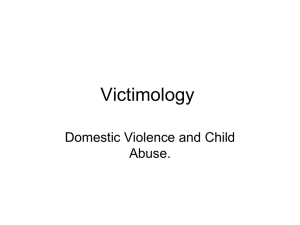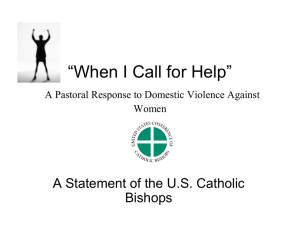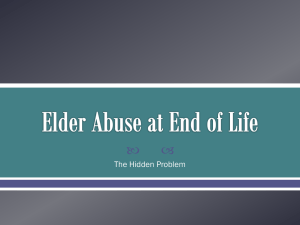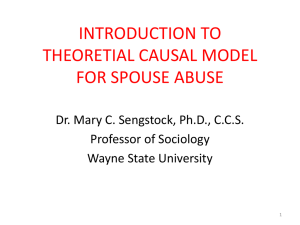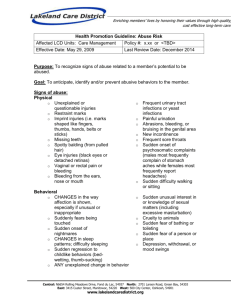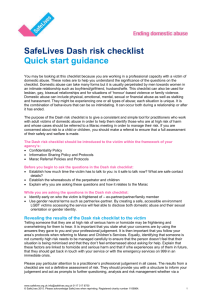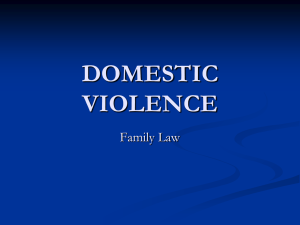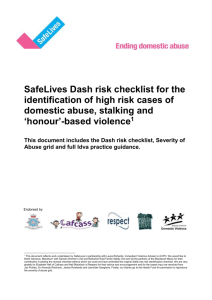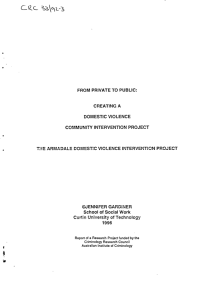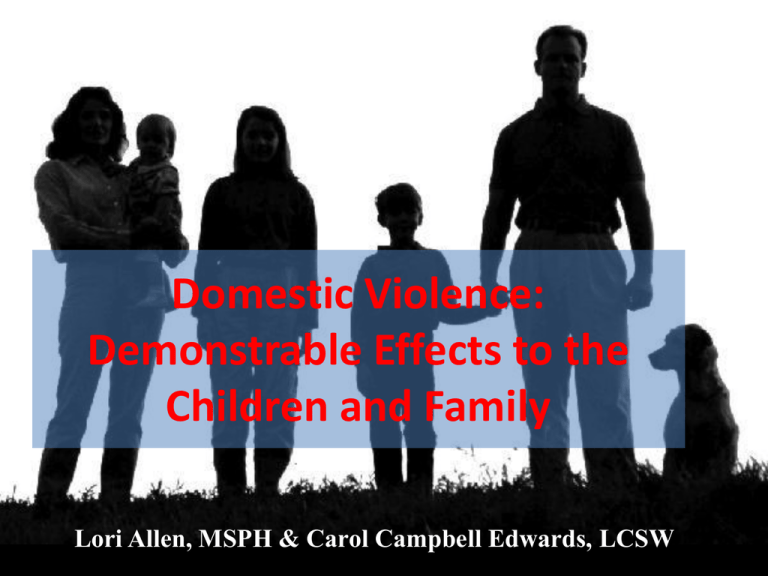
Domestic Violence:
Demonstrable Effects to the
Children and Family
Lori Allen, MSPH & Carol Campbell Edwards, LCSW
Objectives
•Summarize dynamics and common impacts
on family members
•Review approaches to screening
•Identify interventions that assist survivors in
providing safety for themselves and children.
•Identify and develop strategies to partner
with the survivor and community to hold
batterers accountable.
Assess
the
STOP
identifying
family
for
domestic
WHO has
violence by
thesolely
power
looking
and at
the physical
control.
abuse!
Domestic violence is a pattern of
coercive, controlling behaviors
designed to exert power and
control over a person in an
intimate relationship through
the use of intimidation, threats,
physical or psychological harm,
and/or harassment.
DV Statistics
2010-2011,
Florida's certified
DV centers
provided 477,489
nights of
emergency shelter
to 15,789
survivors of DV
and their children.
15.5 million U.S.
children live in
families in which
partner violence
occurred at least
once in the past
year, and 7 million
children live in
families in which
severe partner
violence occurred.
PHYSICAL
ABUSE
SEXUAL ABUSE
• Forcing acts against
the victim’s will
• Coercing the victim to
perform sex acts
through drugs,
threats, or force.
• Hurting the victim
during sex, including
the use of objects or
weapons
• Forcing the victim to
have unprotected sex
• Bruised or bitten
genitals or breasts
• Forced abortions
• Forced pregnancy,
prohibiting use of
contraception
•Threats of harm to the
victim, children, or pets
•Isolation
•Extreme jealousy or
possessiveness
•Withholding basic needs
•Intimidation, degradation,
and humiliation
•Dictating rules of behavior
for the victim
EMOTIONAL
AND
PSYCHOLOGICAL
ABUSE
Strong sense of selfconfidence and ego
Attitude of ownership
over partner/children
Uses male privilege or
social status
Engages in serial abuse
(multiple victims)
Minimization of the
abuse
Disregard of legal
consequences
The Batterer will likely:
• Blame the victim
• Deny the reports of abuse
• Attempt to collude with male
responders, or charm female
responders
• Focus on a need to have the children
with him
• Attempt to focus on victim behaviors
that could be seen as “problems”
Fear is the dominant
motivation for their
actions
May be victims of
childhood abuse
Often develop chronic
physical and mental
health issues
Minimize or hide the
abuse
May be unaware of
resources
Guiding Principles:
The safety of abused children often is linked to the safety of the
adult victims.
Perpetrators of domestic violence who abuse their partner also
emotionally or psychologically harm their children.
It is important to understand potential effects of domestic
violence to children beyond those that are physical in nature.
Supportive, noncoercive, and empowering interventions that
promote the safety of victims and their children should be
incorporated in child protection efforts.
Assessment Factors that Influence the
Impact of Domestic Violence on Children
•Nature of the violence
•Coping strategies and skills
•Age of the child
•Elapsed time since exposure
•Gender
•Presence of child physical or
sexual abuse
Characteristics of Exposed
Children:
• Anxiety and fear
• Aggression
• Poor performance in school
• Substance abuse
• Regression of skills
• Lack of learning behaviors
• Slower development
• Delinquent behaviors
• High propensity to be victims
(girls) or abusers (boys)
• Suicide
• Teen pregnancy
• Sleep disorders
• Eating disorders
• Flat affect and depression
Methods of Abuse by the Batterer that
Affect Children….
Verbal
Abuse
Isolation
Sexual
violence
Economic
Abuse
Physical
Threats
Abuse
of harm
In many instances, victims of domestic
violence pursue aid, education, and
legal options, but the dynamics of the
relationship may prevent a victim from
following through. This does not
indicate that they do not want to
escape or that they are unconcerned
about the situation.
http://www.youtube.com/watch?v=7d4gmdl3zNQ
3 Categories of Childhood Problems
Associated with Exposure to DV
• Behavioral, social,
and emotional
problems
• Cognitive and
attitudinal
problems
• Long-term
problems
Things people say about survivors that
perpetuate blame…
Ensuring Safety—Partnering With
The Survivor
• It is important to remember that
the survivor engages in
behaviors to stay safe.
• Our view of the situation is not
the total picture – the victim
understands the risks better
than we do.
• The survivor’s goal of safety may
conflict with the
investigator/case manger’s goal
of helping her leave or securing
services.
Leaving means leaving
all of it…
She leaves the abuse, but she
also leaves her home, her
stability, her marriage, the father
of her kids.
She also leaves all the intimate,
beautiful moments of the
relationship which is all she has
ever known.
Remember these are families,
they have special memories that
are only theirs. Loss is a powerful
thing, she will mourn it even if it
wasn’t healthy.
Deja Vu All Over Again
Discussion of Safety Planning and
Interventions….
Topics To Consider
•
•
•
•
•
•
•
•
•
•
•
How survivor may get help in an emergency
How survivor may get help if leaving is not an option
How to keep pets and children safe
Discuss transportation
Anticipate batterer’s response to actions taken
Asking about access to communication lines
Make a list of safe people to contact
Establish a code word or sign
Memorize important telephone numbers
Keep change or a charged cell phone available
Always ask about what she would do if her partner were to
become violent.
Diane Malone Story
Maximize Positive Outcomes
1. Validate the survivor's feelings and be sensitive to the
obstacles she may be facing
2. Affirm the perpetrator’s behavior is criminal – don’t
blame the victim for behaviors she cannot control
3. Uphold victim confidentiality
4. Empower the victim to make significant decisions and
solve problems.
5. Provide referrals that will help the victim in the short and
long term.
6. Collaborate with advocacy programs and services that
can ease the transition

